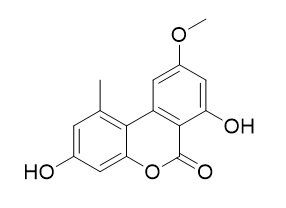Alternariol monomethyl ether
Alternariol monomethyl ether,an Alternaria toxin, is a strong mutagen in Escherichia coli strain ND-160. Alternariol monomethyl ether has genotoxic properties, it can cause oxidative DNA damage.
It also possesses cytotoxic and immunosuppressive properties.
Inquire / Order:
manager@chemfaces.com
Technical Inquiries:
service@chemfaces.com
Tel:
+86-27-84237783
Fax:
+86-27-84254680
Address:
1 Building, No. 83, CheCheng Rd., Wuhan Economic and Technological Development Zone, Wuhan, Hubei 430056, PRC
Providing storage is as stated on the product vial and the vial is kept tightly sealed, the product can be stored for up to
24 months(2-8C).
Wherever possible, you should prepare and use solutions on the same day. However, if you need to make up stock solutions in advance, we recommend that you store the solution as aliquots in tightly sealed vials at -20C. Generally, these will be useable for up to two weeks. Before use, and prior to opening the vial we recommend that you allow your product to equilibrate to room temperature for at least 1 hour.
Need more advice on solubility, usage and handling? Please email to: service@chemfaces.com
The packaging of the product may have turned upside down during transportation, resulting in the natural compounds adhering to the neck or cap of the vial. take the vial out of its packaging and gently shake to let the compounds fall to the bottom of the vial. for liquid products, centrifuge at 200-500 RPM to gather the liquid at the bottom of the vial. try to avoid loss or contamination during handling.
Integr Med Res.2017, 6(4):395-403
J Nat Prod.2019, 82(4):1002-1008
Eur J Pharm Sci.2016, 94:33-45
Molecules.2019, 24(12):E2286
Int J Mol Sci.2023, 24(7):6360.
Appl. Sci.2020, 10(8),2804
Int J Nanomedicine.2024, 19:1683-1697.
Industrial Crops and Products2024, 129:119014
Environ Toxicol.2023, tox.23999.
J Med Food.2020, 23(6):633-640.
Related and Featured Products
Journal of Agricultural & Food Chemistry, 1989, 37(5):1341-1343.
Isolation, identification, and mutagenicity of alternariol monomethyl ether.[Reference:
WebLink]
Alternariol monomethyl ether (AME), an Alternaria toxin, was isolated from the media of Alternaria alternata strain 261, a fungus from grains of Linxian County, China, an area noted for a high incidence of esophageal cancer. AME was purified by silica gel chromatography and recrystallized from acetone.
METHODS AND RESULTS:
The chemical structure was identified by systematic spectral analysis. The 60-MHz proton magnetic resonance spectrum exhibited long-distance couplings between 6′-CH3 and 5′,6-hydrogens, and the assignments to two pairs of meta-coupled aromatic hydrogens were revised. Decoupling experiments supported the new assignments. Irradiation at 2.77 ppm peak (6′-CH3) collapsed the 7.28 ppm dull doublet into sharp peaks and changed the 6.77 ppm diquadruplet into a sharp doublet, while peaks at 6.55 and 6.69 ppm remained unchanged. Therefore, the peaks at 6.55, 7.28, 6.69, and 6.77 ppm should be 3′-, 5′-, 4-, and 6-hydrogens, respectively. AME was a strong mutagen in Escherichia coli strain ND-160. Compared to spontaneous revertants, the number of revertants caused by 50 and 100 μg of AME/plate was 6- and 10-fold greater, respectively.
CONCLUSIONS:
Since Scott reported in 1980 that the mutagenicity of AME to Salmonella typhimurium TA98 was weak or marginal, it appears that the mutagenic action of AME exhibits some selectivity toward specific genomic regions or DNA sequences.
Toxicol Lett. 2012 Oct 2;214(1):46-52.
Minor contribution of alternariol, alternariol monomethyl ether and tenuazonic acid to the genotoxic properties of extracts from Alternaria alternata infested rice.[Pubmed:
22906495 ]
Alternaria spp. are known to form a spectrum of secondary metabolites with alternariol (AOH), Alternariol monomethyl ether (AME), altenuene (ALT) and tenuazonic acid (TA) as the major mycotoxins with respect to quantity.
METHODS AND RESULTS:
In the present study we investigated the contribution of these compounds for the DNA damaging properties of complex extracts of Alternaria spp. infested rice. Five different Alternaria strains were cultured on rice and analyzed for their production of AOH, AME, ALT and TA. The extracts of two strains with distinctly different toxin profiles were selected for further toxicological analysis. An extract from A. alternata DSM 1102 infested rice, found to contain predominantly TA, exhibited substantial DNA strand breaking properties in cultured human colon carcinoma cells in the comet assay, whereas TA as a single compound did not affect DNA integrity up to 200μM. An extract of A. alternata DSM 12633 infested rice, containing in comparable proportions AOH, AME and TA, exceeded by far the DNA damaging properties of the single compounds. In contrast to AOH, AME and TA, both selected extracts induced an increase of DNA modifications sensitive to the bacterial repair enzyme formamidopyrimidine DNA glycosylase (FPG) in the comet assay, indicative for oxidative DNA damage. Toxicity-guided fractionation of the DSM 12633 extract confirmed that these effects were not caused by AOH, AME or TA.
CONCLUSIONS:
Taken together, the mycotoxins AOH, AME and TA, representing the major mycotoxins with respect to quantity in A. alternata infested food, play only a subordinate role for the genotoxic properties of complex extracts and appear not to be involved in the induction of FPG sensitive sites.
Int J Mol Sci. 2017 Jul 20;18(7).
The Alternaria alternata Mycotoxin Alternariol Suppresses Lipopolysaccharide-Induced Inflammation.[Pubmed:
28726766]
The Alternaria mycotoxins alternariol (AOH) and Alternariol monomethyl ether (AME) have been shown to possess genotoxic and cytotoxic properties.
METHODS AND RESULTS:
In this study, the ability of AOH and AME to modulate innate immunity in the human bronchial epithelial cell line (BEAS-2B) and mouse macrophage cell line (RAW264.7) were investigated. During these studies, it was discovered that AOH and to a lesser extent AME potently suppressed lipopolysaccharide (LPS)-induced innate immune responses in a dose-dependent manner.
Treatment of BEAS-2B cells with AOH resulted in morphological changes including a detached pattern of growth as well as elongated arms.
CONCLUSIONS:
AOH/AME-related immune suppression and morphological changes were linked to the ability of these mycotoxins to cause cell cycle arrest at the G2/M phase.
This model was also used to investigate the AOH/AME mechanism of immune suppression in relation to aryl hydrocarbon receptor (AhR). AhR was not found to be important for the immunosuppressive properties of AOH/AME, but appeared important for the low levels of cell death observed in BEAS-2B cells.



